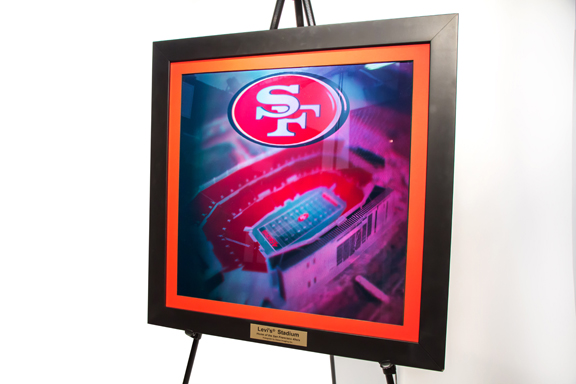
Zebra Imaging, based in Austin, Texas, offers hologram prints. Shown here is the hologram of a sports stadium. (Image courtesy of Zebra Imaging.)
March 17, 2016
 Zebra Imaging, based in Austin, Texas, offers hologram prints. Shown here is the hologram of a sports stadium. (Image courtesy of Zebra Imaging.)
Zebra Imaging, based in Austin, Texas, offers hologram prints. Shown here is the hologram of a sports stadium. (Image courtesy of Zebra Imaging.)Presenting your design to a potential client as a photoralistic 3D rendering was once a guaranteed showstopper, but no more. These days, a 3D rendering is not a novelty but a necessity, the minimum threshold you must meet for the Wow factor.
But what if you pull out a hologram instead? Now there’s the potential to drop a few jaws.
The Austin-based Zebra Imaging has been printing (if you can call it that) holographic plates for clients in architecture, construction and engineering, oil & gas, and retail industries for some time. It now turns its attention to manufacturing.
The company points out the advantages of holograms: “It’s true 3D, no glasses required, enjoy a 360-degree viewing angle, ...
Stereoscopic displays can produce hologram-like visuals with simulated depth; however, it usually requires special display and glasses for viewing. Zebra Imaging’s technology, on the other hand, projects hologram from a horizontal or vertical plate with no additional gadget. The printed hologram plates are also incredibly easy to carry.
Zebra Imaging can also arrange what it calls “channeling,” whereby you can incorporate several different layers of information into the same model. For example, a holographic plant model may reveal the exterior in one angle and the interior machinery in another. Such a model would make it easy for clients to understand collisions and clashes. By contrast, a 3D-printed model could only display your project—be it a building or a mechanical assembly—in a single dimension.
Using channeling, Zebra Imaging can also produce an animated effect. Eric Doane, Zebra Imaging’s marketing manager, explained “Channeling is segmenting viewing angles and showing different static 3D image files, so think of it like a flip book. When you flip through it really fast, it feels like there is an animation, yet all the pages are static images. This is what we are doing with the 3D files when we channel.”
Since holograms rely on light to work, you do need to provide something akin to a theatrical spotlight so the hologram can shine, so to speak. If there’s too much light in the surrounding to compete with the activating light, it could compromise the holographic experience. That means it works best in an environment where you can control the ambient light and the primary light source. Zebra Imaging sells portable light that works well with its printed plates. It also offers display tables, dubbed ZScape.
Pricing, too, might be a consideration. With 3D printing, larger print jobs that demand more materials cost more. Smaller scale-models are much more affordable.
Doane said, “To compare the prices alone would not be fair to either technology, as the two products aren’t as similar as they seem from the top level. I would say it’s more use case than price. When a firm really wants to be innovative and put the full court press on during competitive bids for jobs, they would use a hologram.”
In a project where examining the contour, fit, and ergonomics of the design is important (for example, in designing a surgical instrument), the tangible 3D-printed model may be a better fit than a hologram. But if the design’s scale is too big for 3D printing (for example, the structure of an offshore oil rig), the hologram may be a better option.
Doane remarked, “If you’re doing design review, you would use a 3D print—That is currently the way. Obviously we want to move our technology forward so on-demand hologram printing in the office is possible and would compete with 3D printing. However, we are not at that point yet.”
The holographic prints come in various standard sizes, available in monochrome as well as color. (See Zebra Imaging’s pricing chart here.) The process is similar to ordering a 3D-printed prototype or scale model from a 3D printing service bureau. You choose the desired dimension, upload the file, and get the holographic plate in the mail.
For those who want to bring holographic printing in-house, and have a sizable budget, Zebra Imaging offers Holographic Printers, priced beginning at one million.
For more, watch Zebra Imaging’s video demonstration below.
Subscribe to our FREE magazine, FREE email newsletters or both!
About the Author
Kenneth Wong is Digital Engineering’s resident blogger and senior editor. Email him at [email protected] or share your thoughts on this article at digitaleng.news/facebook.
Follow DE





